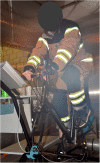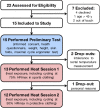Prediction of Core Body Temperature Based on Skin Temperature, Heat Flux, and Heart Rate Under Different Exercise and Clothing Conditions in the Heat in Young Adult Males
- PMID: 30618795
- PMCID: PMC6295644
- DOI: 10.3389/fphys.2018.01780
Prediction of Core Body Temperature Based on Skin Temperature, Heat Flux, and Heart Rate Under Different Exercise and Clothing Conditions in the Heat in Young Adult Males
Abstract
Non-invasive, multi-parameter methods to estimate core body temperature offer several advantages for monitoring thermal strain, although further work is required to identify the most relevant predictor measures. This study aimed to compare the validity of an existing and two novel multi-parameter rectal temperature prediction models. Thirteen healthy male participants (age 30.9 ± 5.4 years) performed two experimental sessions. The experimental procedure comprised 15 min baseline seated rest (23.2 ± 0.3°C, 24.5 ± 1.6% relative humidity), followed by 15 min seated rest and cycling in a climatic chamber (35.4 ± 0.2°C, 56.5 ± 3.9% relative humidity; to +1.5°C or maximally 38.5°C rectal temperature, duration 20-60 min), with a final 30 min seated rest outside the chamber. In session 1, participants exercised at 75% of their heart rate maximum (HR max) and wore light athletic clothing (t-shirt and shorts), while in session 2, participants exercised at 50% HR max, wearing protective firefighter clothing (jacket and trousers). The first new prediction model, comprising the input of 18 non-invasive measures, i.e., insulated and non-insulated skin temperature, heat flux, and heart rate ("Max-Input Model", standard error of the estimate [SEE] = 0.28°C, R2 = 0.70), did not exceed the predictive power of a previously reported model which included six measures and no insulated skin temperatures (SEE = 0.28°C, R2 = 0.71). Moreover, a second new prediction model that contained only the two most relevant parameters (heart rate and insulated skin temperature at the scapula) performed similarly ("Min-Input Model", SEE = 0.29, R2 = 0.68). In conclusion, the "Min-Input Model" provided comparable validity and superior practicality (only two measurement parameters) for estimating rectal temperature versus two other models requiring six or more input measures.
Keywords: core body temperature; exercise; heart rate; heat flux; heat strain; prediction model; rectal temperature; skin temperature.
Figures






References
-
- ACGIH (2017). TLVs and BEIs: Threshold Limit Values for Chemical Substances and Physical Agents and Biological Exposure Indices. Cincinnati, OH: American Conference of Governmental Industrial Hygienists.
LinkOut - more resources
Full Text Sources
Other Literature Sources

